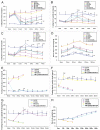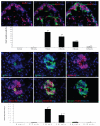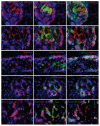Transient overexpression of cyclin D2/CDK4/GLP1 genes induces proliferation and differentiation of adult pancreatic progenitors and mediates islet regeneration
- PMID: 22373529
- PMCID: PMC3318104
- DOI: 10.4161/cc.11.4.19120
Transient overexpression of cyclin D2/CDK4/GLP1 genes induces proliferation and differentiation of adult pancreatic progenitors and mediates islet regeneration
Abstract
The molecular mechanism of β-cell regeneration remains poorly understood. Cyclin D2/CDK4 expresses in normal β cells and maintains adult β-cell growth. We hypothesized that gene therapy with cyclin D2/CDK4/GLP-1 plasmids targeted to the pancreas of STZ-treated rats by ultrasound-targeted microbubble destruction (UTMD) would force cell cycle re-entry of residual G(0)-phase islet cells into G(1)/S phase to regenerate β cells. A single UTMD treatment induced β-cell regeneration with reversal of diabetes for 6 mo without evidence of toxicity. We observed that this β-cell regeneration was not mediated by self-replication of pre-existing β cells. Instead, cyclin D2/CDK4/GLP-1 initiated robust proliferation of adult pancreatic progenitor cells that exist within islets and terminally differentiate to mature islets with β cells and α cells.
Figures







Similar articles
-
α-cell role in β-cell generation and regeneration.Islets. 2012 May-Jun;4(3):188-98. doi: 10.4161/isl.20500. Islets. 2012. PMID: 22847495 Free PMC article. Review.
-
Successful β cells islet regeneration in streptozotocin-induced diabetic baboons using ultrasound-targeted microbubble gene therapy with cyclinD2/CDK4/GLP1.Cell Cycle. 2014;13(7):1145-51. doi: 10.4161/cc.27997. Epub 2014 Feb 10. Cell Cycle. 2014. PMID: 24553120 Free PMC article.
-
Mangiferin facilitates islet regeneration and β-cell proliferation through upregulation of cell cycle and β-cell regeneration regulators.Int J Mol Sci. 2014 May 20;15(5):9016-35. doi: 10.3390/ijms15059016. Int J Mol Sci. 2014. PMID: 24853132 Free PMC article.
-
Ectopic transgenic expression of NKX2.2 induces differentiation of adult pancreatic progenitors and mediates islet regeneration.Cell Cycle. 2012 Apr 15;11(8):1544-53. doi: 10.4161/cc.19928. Epub 2012 Apr 15. Cell Cycle. 2012. PMID: 22433950
-
In vivo regeneration of insulin-producing beta-cells.Adv Exp Med Biol. 2010;654:627-40. doi: 10.1007/978-90-481-3271-3_27. Adv Exp Med Biol. 2010. PMID: 20217517 Review.
Cited by
-
A noval noninvasive targeted therapy for osteosarcoma: the combination of LIFU and ultrasound-magnetic-mediated SPIO/TP53/PLGA nanobubble.Front Bioeng Biotechnol. 2024 Jun 28;12:1418903. doi: 10.3389/fbioe.2024.1418903. eCollection 2024. Front Bioeng Biotechnol. 2024. PMID: 39007051 Free PMC article.
-
Mangiferin induces islet regeneration in aged mice through regulating p16INK4a.Int J Mol Med. 2018 Jun;41(6):3231-3242. doi: 10.3892/ijmm.2018.3524. Epub 2018 Mar 1. Int J Mol Med. 2018. PMID: 29512742 Free PMC article.
-
Enhanced differentiation of human pluripotent stem cells into pancreatic progenitors co-expressing PDX1 and NKX6.1.Stem Cell Res Ther. 2018 Jan 23;9(1):15. doi: 10.1186/s13287-017-0759-z. Stem Cell Res Ther. 2018. PMID: 29361979 Free PMC article.
-
α-cell role in β-cell generation and regeneration.Islets. 2012 May-Jun;4(3):188-98. doi: 10.4161/isl.20500. Islets. 2012. PMID: 22847495 Free PMC article. Review.
-
Successful β cells islet regeneration in streptozotocin-induced diabetic baboons using ultrasound-targeted microbubble gene therapy with cyclinD2/CDK4/GLP1.Cell Cycle. 2014;13(7):1145-51. doi: 10.4161/cc.27997. Epub 2014 Feb 10. Cell Cycle. 2014. PMID: 24553120 Free PMC article.
References
Publication types
MeSH terms
Substances
Grants and funding
LinkOut - more resources
Full Text Sources
Other Literature Sources
Medical
